PEOPLE
2-10 depending on the size of the team. If it becomes larger than 10 people consider breaking out into smaller groups.
TIME
30-60 Minutes. No one wants to be in a meeting longer than needed. Try to keep it short and sweet.
NINJA LEVEL
Practitioner to Master. It may take some practice to run this play.
PREP WORK
PLAYS
Prior to this play you will need to have acceptance of the work delivered.
PEOPLE
The right people are key to the success of this play. This play can be ran for numerous launches so the key people may be from all different areas or even external to your organization. Review the invite list to ensure that all the various experts are in the room.
PLACE
Virtually or in-person it is critical that everyone has face-time with each other. So make sure that if attending virtually that everyone can connect in video chat. You will also need to share ideas, so a whiteboard is important and a space that fosters creativity and innovation.
THE PLAY
All of our plays are five steps or less! However, you may need to run multiple plays to get the most out of this one. Don’t worry – you can do it! Learn the play, rehearse it regularly, apply it in the field and debrief on the outcomes. If it worked well, use it again; if it didn’t, find out why. Are there new factors in the system you need to consider, or do you just need to keep practicing? If you need help or have questions on this play, contact us!
01
SET THE STAGE
Who are the players?
Every winning team knows which players to have on the field and what talent you need on the ready. To successfully deploy this play you will need the following roster:
![]() Meeting Facilitator: Likely this is you! But you don’t have to do it alone, ask a friend (think of it like a football team that has a coach for different parts of the team). Skills needed:
Meeting Facilitator: Likely this is you! But you don’t have to do it alone, ask a friend (think of it like a football team that has a coach for different parts of the team). Skills needed:
- Keep the team focused on the goal!
- Foster a positive and creative space for all.
- Organized and prepared to run play.
![]() Subject Matter Experts (SMEs): A SME (pronounced S-Mee) is critical for this play. They will help drive the team to a shared understanding of what is needed to win. Skills needed:
Subject Matter Experts (SMEs): A SME (pronounced S-Mee) is critical for this play. They will help drive the team to a shared understanding of what is needed to win. Skills needed:
- Specific domain knowledge, narrow and deep rather than broad and shallow.
- Communication and team collaboration. They must be able to share with others the knowledge they have on a particular subject.
Get the field ready!
![]() Schedule the meeting in advance. Don’t wait until the last minute to schedule the meeting. You want people to be excited about it but not so last minute that they have no time to prepare.
Schedule the meeting in advance. Don’t wait until the last minute to schedule the meeting. You want people to be excited about it but not so last minute that they have no time to prepare.
![]() Include an agenda. Set expectations – this will help keep your meeting on track. Include schedule and any prep work needed. Also let them know if it is okay to invite others or not. Remember that if you have to many people in the meeting, it will be difficult to facilitate brainstorming sessions without breaking out into smaller groups.
Include an agenda. Set expectations – this will help keep your meeting on track. Include schedule and any prep work needed. Also let them know if it is okay to invite others or not. Remember that if you have to many people in the meeting, it will be difficult to facilitate brainstorming sessions without breaking out into smaller groups.
![]() Prep the room. Arrive early and get ready. If it is in a physical room, get whiteboards ready, enough chairs for everyone, water and snacks are always a hit! If virtually, a central location for notes, brainstorms and follow-up items. Test connectivity in the meeting room and make sure there is enough seats for all participants.
Prep the room. Arrive early and get ready. If it is in a physical room, get whiteboards ready, enough chairs for everyone, water and snacks are always a hit! If virtually, a central location for notes, brainstorms and follow-up items. Test connectivity in the meeting room and make sure there is enough seats for all participants.
02
CORE ACTIVITIES
DRESS REHEARSAL
This may not be needed for all launches but most will benefit from a dry run through of the go-live activities. A little prep will be needed to make this go smooth but can be done in real time as well for smaller launches.
- You will need a central meeting space and instant collaboration tools. For software this usually means a virtual meeting room and integrated chat/voice capabilities. For product launch this might mean an open conference call line or a physical meeting room at the location. This is often referred to as a war room, as it is central command center for the entire operation.
- Think through all launch activities and who will you need available if things go off the rails at any step? Who will step in to fix it on the spot? That is your launch team.
- This may include resources that were not part of the project team. That’s okay as long as they can be briefed on the project objective and scope of work involved.
- Document all the activities of the launch. Assigned a single point person for each activity. The activity itself may include multiple people to get it done but you need one single person as point of contact who will own overseeing activity through completion.
- Prepare any necessary components that will be used for the go-live activities. For software projects this may include a staging environment or for other projects may be a training guide or user manual. Do as much preliminary work as possible now.
- Meet together with the team and review all activities in the plan. Open the floor for questions or clarifying feedback. Now run through the activities as close as possible to the actual go-live event. Check-in with the team after every activity to see how it went and if any revisions are needed.
THE BIG DAY
This is it. All the hard work, blood, sweat and tears is about to be worth it. Get excited about the day and activities that are about to take place. Energize the team (also stock up on snacks and drinks for the team).
- Put it on the calendar. Send the meeting invite to everyone who will be involved in the launch activities. Be sure to make it clear the meeting room and conference call in number. Attach the go-live plan as well.
- Meet in the war room. Be there early and open it up for any last minute questions. Double check with everyone they have everything they need for the launch. Ask if there is any last minute changes. Update everyone with the most recent go-live plan.
- Run go-live plan and launch activities. Check-in often. Over communicate. When things don’t go as planned (and something inevitably always does) regroup with the team and ask for alternative solutions. This is not the time for blame, hostility or unnecessary drama. Keep focused on the goal and revise the plan with the new approach. Complete the entire plan and activities.
- CELEBRATE!! No matter what, celebrate. Congratulate one another, and recognize those that went above and beyond to make it work. This is the on the field celebration after winning the big game. Remember it took a team effort and thank the team.
DAY AFTER
This might be the same day but it is after all the launch activities are complete and the celebration has occurred. This is the team back in the locker room discussing the winning game.
- Validate that everything is still going well and that no fires need put out. In software this is production validation activities but in non-tech projects this might be a check-in with the team to make sure everything is okay.
- Retrospect on the go-live plan and launch activities. Review:
- What went well?
- What could have gone better?
- What should we change for next time?
Want to learn more about Agile War Rooms and why your team needs one? Check out this article by Hygger.
03
 TEAM HUDDLE
TEAM HUDDLE
Time to run the Team Huddle play. Ask the team the following questions and then take a vote. Keep follow-up questions to a minimum and capture any issues raised as an offline follow-up (and be sure to follow-up).
Understand the play?
![]() The play was understood and I asked any questions in time!
The play was understood and I asked any questions in time!
![]() I’m not sure I understand and I have some questions …
I’m not sure I understand and I have some questions …
![]() I did not understand the play or my part in it.
I did not understand the play or my part in it.
Did you get in the game?
![]() Yes, I made my moves and was in the right place at the right time!
Yes, I made my moves and was in the right place at the right time!
![]() I’m not sure I understand what I was supposed to do …
I’m not sure I understand what I was supposed to do …
![]() I kept the bench warm and watched from the sidelines.
I kept the bench warm and watched from the sidelines.
Ready for what’s next?
![]() Yes, I know the game plan and ready to win!
Yes, I know the game plan and ready to win!
![]() I’m not sure what’s next or if I am involved …
I’m not sure what’s next or if I am involved …
![]() No clue what’s next and would rather sit it out.
No clue what’s next and would rather sit it out.
04
NEXT STEPS
GOOOOAAAALLLLLLL! Congratulate the team on a very successful and productive launch!

![]() Publish plan and lessons learned in a central repository that the team has access to immediately. Even better if it is someplace that the team can add comments or collaborate on. Keep the creative chat going!
Publish plan and lessons learned in a central repository that the team has access to immediately. Even better if it is someplace that the team can add comments or collaborate on. Keep the creative chat going!
05
IT’S A WRAP
You did it! Now just a few follow-up items:
- Reflect on the play. Ask yourself how it went? What could have gone better, what could have gone worse? In sports this is watching the game again to see any plays that could have been better. Update your playbook. Build feedback loops that help you see what’s working; what’s not; and how to continue to develop the playbook by learning, adapting and iterating constantly as situations change and new challenges arise.
- Contribute to the community of Playbook.Ninja. Sign-up for an account and receive updates on when new plays are added and help others by commenting on the plays with what worked or your experience.
Thank you for being a Playbook.Ninja
![]()


 TEAM HUDDLE
TEAM HUDDLE